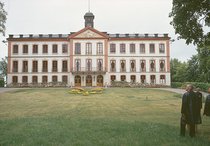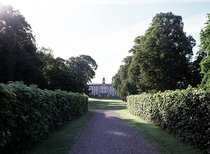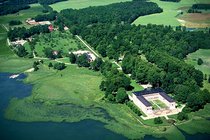Tullgarn
The royal palace at Tullgarn is from the 18th century. It occupies an ostentatious site on a promontory at Mörköfjärden, between Södertälje and Trosa.
A lime avenue of length 2 km leads from the old road to Tullgarn Palace. An atmosphere of the 18th century lies over the complete site, but its roots go back to the mediaeval age. The aristocracy made sure that it owned the bountiful land in this region, and forced the peasants to become crofters and tenant farmers. In the centre of the imposing landscape lies a burial site from the late iron age, silent witness to the ancient roots of Tullgarn, as is also a disused mediaeval village site.
The current palace at Tullgarn was built on commission for Magnus Julius De la Gardie, and was completed in 1727. The architect was French, JG Destain. The palace was purchased by the Swedish state in 1772 to be used as residence for Fredrik Adolf, the younger brother of Gustav III. He had Tullgarn rebuilt in neo-classical style. The furniture and fittings are mainly from the time of Fredrik Adolf. It was also at this time that the house for the palace manager (vogt) was built, where Tullgarns Inn today is located. The prince’s mistress Sophie Hagman lived at the gatekeeper’s lodge, at the beginning of the avenue in the Bellevue park. And it was the artistic Fredrik Adolf who was responsible for the construction of the park.
Gustav V favourite palace
The royal person who is most closely associated with Tullgarn is King Gustav V. He moved here in 1881 when he was crown prince together with his consort, the German princess Victoria. During his long life – he died in 1950, aged 91 – he spent nearly every summer at Tullgarn.
The surroundings of Tullgarn are a nature reserve, and botanically this is one of the richest areas of Sweden. Here you can find, for example, orchids such as the musk orchid and the marsh helleborine.
The hill to the south of Västerviken gives a fantastic view over the Tullgarn bay.
The name Tullgarn has nothing to do with customs (in Swedish “tull”), but is derived from the Swedish word for a stand of pine trees, “tylle”. “Garn” describes a narrow bay.
The palace and park are open to the public during the summer.
Links
Nearest public transport Tullgarn.



